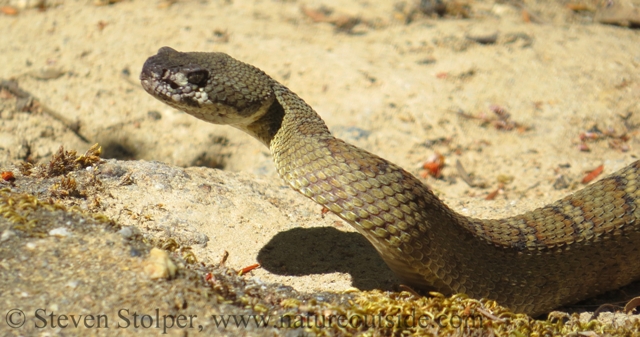
Northern Pacific Rattlesnake
I won’t lie, I feel lucky to be typing this.
I nearly stepped between two enormous, hormone-crazed, Northern Pacific Rattlesnakes. The male snakes were engaged in a combat dance. And if you haven’t seen one, it’s an amazing site! But right now I feel the sudden urge to review rattlesnake safety tips.
Rattlesnakes – The Straight Dope
When it comes to venomous snakes, we’re lucky to live in the United States. Rattlesnakes are generally not aggressive. Their first line of defense is to remain motionless. Camouflage usually masks their presence.
Rattlesnakes’ second line of defense is a diplomatic retreat. The heavy-bodied snakes glide into cover if given the chance.
And if threatened, the snakes rattle the auditory alarm that makes them famous. This is their third defense.
Rattlesnakes strike as a last resort. Many bites occur when people handle the snakes or accidentally touch them while walking or climbing. Most reported bites occur on the hands, feet, and ankles. Even then, the snakes don’t want to waste their precious venom on an animal they can’t eat. Between 25%-50% of rattlesnake bites are “dry.”
It’s true that rattlesnake bites can be extremely dangerous. But they’re not aggressive, belligerent, or high strung. They only bite without warning when trodden or touched.
The same cannot be said of snakes in other parts of the world. I’ve hiked in Africa, Australia, and Central America. I appreciate how our rattlesnake is a good citizen compared to venomous snakes from other regions.
So it’s really up to us to avoid situations where we suffer rattlesnake bites. Let’s take a look at nine tips to help us do it.
Rattlesnake Safety Tips for Hikers
The following tips mix my own experience with recommendations by the California Department of Fish and Wildlife.
1. Be Vigilant
The snakes are crepuscular and nocturnal. So they are likely to be resting during the day. I always look for them beside the trail where shade meets sunlight. The snakes prefer to sun themselves where cover is nearby.
2. Wear Hiking Boots
Wear hiking boots. Don’t hike barefoot or wear sandals when walking through wilderness areas. I know barefoot hikers and sandal wearers will object. But you are safer having a layer of leather between you and the snake.
In the same vein, wear mid-rise or high-top boots and loose-fitting long pants.
3. Stick to the Trail
In high risk areas stay on the trail. You have better visibility, which helps you spot the snake. Rattlers may also be accustomed to people on the trail and will yield to your approach. Avoid tall grass and heavy underbrush where snakes may hide during the day.
4. Do not step where you cannot see. Do not put your hands where you cannot see.
Do not step or put your hands where you cannot see. Step on logs and rocks instead of stepping over them. Pay attention while climbing rocks or gathering firewood. Inspect stumps, rocks, and logs before sitting down.
If you are camping overnight, avoid stumbling about in the dark. Remember to shake out your sleeping bag before use.
5. Do not handle a freshly killed snake
The carcass can still bite and inject venom by reflex.
6. Teach children to respect snakes
Teach children to respect snakes and to leave them alone. Children are naturally curious (and fearless). They may pick up snakes or “play” with them if not coached.
7. Be careful stepping outside
I was unaware of this tip for many years. Be careful when stepping over the doorstep. Apparently snakes like to crawl along the edge of buildings where they feel protected on one side.
8. Don’t grab floating branches while swimming
Never grab “sticks” or “branches” while swimming in lakes and rivers. I have never seen them do it, but rattlesnakes swim.
9. Hike with a buddy
It is safer in many respects to have someone who can help in a wilderness emergency. Having a hiking partner who can assist you (and think clearly for you) is a big help if you’re bitten.
If you are Bitten
Only a small number of rattlesnake bites prove fatal to healthy adults. If a rattlesnake bites you, the California Department of Fish and Wildlife advises:
- Stay calm
- Wash the bite area gently with soap and water
- Remove watches, rings, etc, which may constrict swelling
- Immobilize the affected area
- Transport safely to the nearest medical facility
The latest research seems to show that snakebite kits do not work. Get the patient calmly to medical care. That’s your best bet.
Conclusion
While rattlesnake bites can be dangerous, the snakes are generally not aggressive and bite only as a last resort. If you are vigilant and hike safely, you should enjoy many happy years rambling in rattlesnake territory.
Related Articles
Mountain Kingsnake – Beauty and Danger!
Twisted, Tangled, Trapped and Rattling!
Gopher Snake – Master Impersonator!
For fun facts and useful tips, join the free Bushcraft Newsletter.



Hi Steve! Great article on rattlesnakes!
A friend of mine and herpetologist, Terry Vandeventer, suggest when encountering ANY snake: “Take two steps backwards, turn and walk away”
Tommy
I’m glad you enjoyed the article, Tommy. I like your friend’s advice. It’s especially good advice for venomous snakes.
My only close call with a rattlesnake was stepping out of a sea container in an army training area in Southern Alberta. Early in the morning the snake was under the doorway as people were walking out the door. By the fourth person it had started to rattle and make itself known. Took a while for it to warm up enough in the sun to move away on its own. I guess in the cold summer nights on the prairie the snakes enjoyed the metal shipping containers heat from the previous warm day.
Good tips.
Wow, that could have ended badly! It makes sense that the container provided radiant heat and shelter for the snake. Glad everyone was OK.